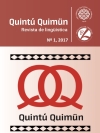Interpretación humana y pares derivativos / Human interpretation and derivative pairs
Contenido principal del artículo
Resumen
Palabras clave: género, español, hipermarcación, individuación, pares derivativos
ABSTRACT
Spanish gender-marked “derivative pairs” (manzana, ‘apple’-fem/manzano, ‘apple tree’-masc) differ from human Ns (tío, ‘uncle’-masc/tía, ‘uncle´-fem) in that they do not show a sex based gender interpretation. The derivative pairs including the agentive suffixes /-ero/ and /-dor/ as well as the augmentative /-ón/ are very productive. By assuming that gender features [+fem] and [-fem] can be specified in Syntax, we propose that in human Ns as well as in productive derivative pairs, N is first marked with both gender features as [+fem, -fem]. We call this condition hypermarkedness and, through it, human interpretation of the nominal (which is not related, then, to a “primitive” feature [human]) and specification as [+fem] or [-fem] is possible. In suffixed productive derivative pairs, hypermarkedness cannot be interpreted in LF. However the derivation “is saved” by specifying a gender value, which is related to a higher degree of individuation. As for “fruit” pairs like manzana/manzano, the masculine is hipermarked. This can be interpreted in LF but it cannot be specified as [+fem] or [-fem].
Keywords: Spanish gender, hypermarkedness, individuation, derivative pairs
Descargas
Detalles del artículo
Los autores de los artículos publicados conservan los derechos de copyright.
Licencia de uso:

Creative Commons Atribución-NoComercial-CompartirIgual 4.0 Internacional.
Citas
Ambadiang, Theophile (1993) La morfología flexiva. Madrid: Taurus.
Baker, Mark (2008) The Syntax of Agreement and Concord. Cambridge: Cambridge Press.
Borer, Hagit (2005) In Name Only. Oxford: Oxford University Press.
Calabrese, Andrea (2005) Markedness and Economy in a Derivational Model of Phonology. Berlin: Mouton de Gruyter.
Corbett, Greville (1991) Gender. Cambridge: Cambridge University Press.
Cowell, Mark (1964) A Reference Grammar of Syrian Arabic. Washington: Georgetown University Press.
Crisma, Paola, Lutz Marten & Rint Sybesma (2011) The point of Bantu, Chinese and Romance nominal classification. Rivista di Linguistica 23(2): 251-99.
Chomsky, Noam (1995) The Minimalist Program. Cambridge, Mass: MIT Press.
Embick, David (2010) Localism versus Globalism in Morphology and Phonology. Cambridge, Mass: MIT Press.
Estomba, Diego (2014) Adjetivos relacionales y la proyección funcional del nombre. RASAL 2014: 73-94.
Estomba, Diego (2016) El género sintáctico y la proyección funcional del nombre. Tesis de Maestría. Universidad Nacional del Comahue.
Fassi Fehri, Abdelkader (2004) Nominal classes, reference, and functional parameters, with particular reference to Arabic. Linguistic Variation Yearbook 4: 41–108.
Ferrari-Bridgers, Franca (2008) A unified syntactic analysis of Italian and Luganda nouns. En Cécile De Cat & Katherine Demuth (eds.) The Bantu-Romance Connection; a comparative investigation of verbal agreement, DPs and information structure. Amsterdam: John Benjamins. 239-258.
Geach, Peter (1962) Reference and generality. Ithaca: Cornell University Press.
Gupta, Anil (1980) The logic of common nouns. New Haven: Yale University Press.
Halle, Morris (1997) Distributed Morphology: Impoverishment and fission. En Benjamin Bruening, Yoonjung Kang & Maureen McGinnis (eds.), MIT Working Papers in Linguistics. Cambridge: MIT. 425-449.
Halle, Morris & Alec Marantz (1993) Distributed Morphology and the pieces of inflection. En Ken Hale & Samuel Keyser (eds.), The view from Building 20: Essays in linguistics in honor of Sylvain Bromberger. Cambridge, Mass: MIT Press. 111-76.
Harbour, Daniel (2007) Morphosemantic number. From Kiowa Noun Classes to UF Number features. Dordrecht: Springer.
Harris, James (1991) The Exponence of Gender in Spanish. Linguistic Inquiry 22: 65-88.
Kornfeld, Laura (2010) La cuantificación de adjetivos en el español de Argentina. Buenos Aires: El 8vo.Loco.
Marantz, Alec (1997) No Escape from Syntax: Don’t try Morphological Analysis in the Privacy of Your Own Lexicon. En Alexis Dimitriadis et al (eds.) Proceedings of the 21st Penn Linguistics Colloquium, 201-225.
Real Academia Española [RAE]/Asociación Academias de la Lengua Española [ASALE] (2009) Nueva gramática de la lengua española, 2 vols. Madrid: Espasa Calpe.
Resnik, Gabriela (2010) Los nombres eventivos no deverbales en español. Tesis doctoral. Universitat Pompeu Fabra.
Ritter, Elizabeth (1991) Two functional categories in Noun Phrases: evidence from Modern Hebrew. En Susan Rothstein (ed.), Perspectives on Phrase Structure. New York: Academic Press. 37-62.
Saab, Andrés (2004) El dominio de la elipsis nominal en español: identidad estricta e inserción tardía. Tesis de maestría. Universidad Nacional del Comahue.
Saab, Andrés (2008). Hacia una teoría de la identidad parcial en la elipsis. Tesis doctoral. Universidad de Buenos Aires.
Watson, Janet (2002) The Phonology and Morphology of Arabic. Oxford: Oxford University Press.
Wright, William (2007[1896]). A Grammar of the Arabic Language I. Londres: Simon Wallenberg Press.
